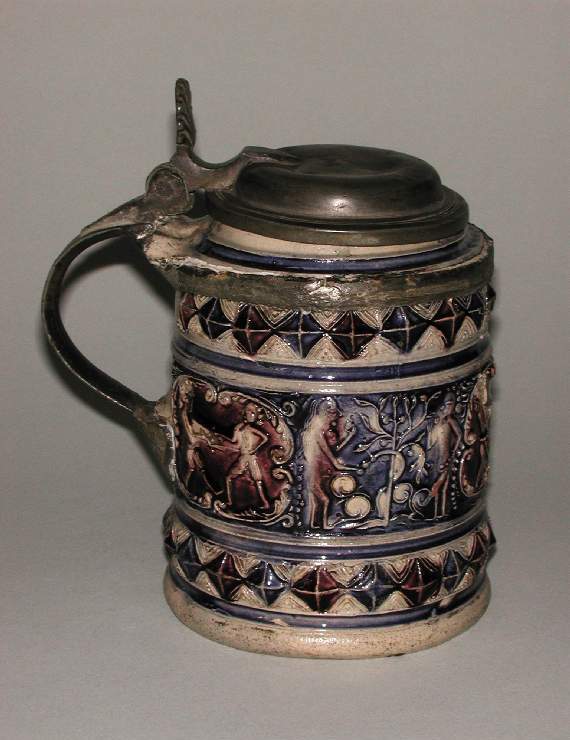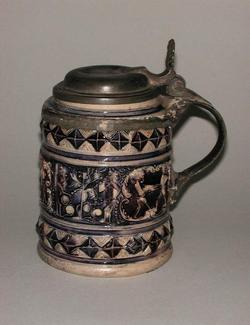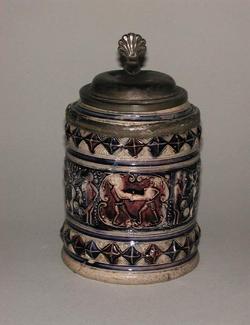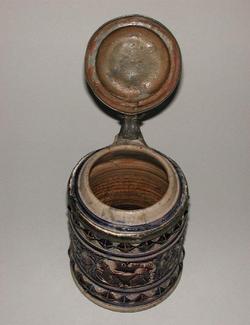Current Location: In storage
Maker(s)
Production:
Unidentified Westerwald pottery
Entities
Categories
Description
Greyish-buff salt-glazed stoneware decorated on the main field with a relief of Adam and Eve, flanked by cartouches containing two men fighting with swords, coloured in blue and manganese-purple; pewter mounts, cover, and replacement handle
Greyish-buff stoneware, thrown, decorated with applied moulded reliefs, coloured in blue and manganese-purple, and salt-glazed. The handle has been replaced in pewter, and is attached to a band around the upper part of the sides, and by means of a hinge, to a shell-shaped thumb piece, and a low domed cover. The cylindrical tankard has sides which slope inwards slightly towards the top where they contract to provide a ledge for the cover to rest on. Round the middle of the sides is a wide band with a central relief of Adam and Eve on either side of the Tree of Knowledge, flanked by scrolled cartouches enclosing two men fighting with swords, who wear knee breeches and hats with feathers. Above and below is a horizontal blue band between cordons and a band of lozenge diamond motifs in relief coloured alternately blue and purple. Another blue band encircles the top above the pewter mount.
Notes
History note: Crome’s Antique Shop, Crosby Square, Bishopsgate Street, EC., where bought for £1 on 2, March 1912 by Dr J.W.L. Glaisher, FRS, Trinity College, Cambridge
Legal notes
Dr J. W. L. Glaisher Bequest
Measurements and weight
Height: 16.3 cm
Height: 3 cm
Width: 13.6 cm
Acquisition and important dates
Method of acquisition: Bequeathed
(1928-12-07)
by
Glaisher, J. W. L., Dr
Dating
18th Century, first half
Circa
1700
-
1750
Note
The stoneware industry in the Westerwald developed first in the area of three villages, Höhr, Grenzau and Grenzhausen (currently Höhr-Grenzhausen), where potters formed a guild in 1643, and expanded to other villages in the area. Production increased greatly after the end of the Thirty Years War in 1648, and Westerwald stoneware was exported on a large scale to other parts of Europe, including Britain. Typically the vessels made, such as tankards and jugs, had a pale grey body with incised or applied relief decoration coloured in blue or blue and manganese-purple before salt-glazing.
School or Style
Baroque
People, subjects and objects depicted
Components of the work
Decoration
composed of
high-temperature colours
( cobalt-blue and manganese-purple)
Mounts, Handle
composed of
pewter
( probably)
Surface
composed of
salt-glaze
Base
Diameter 10 cm
Body
Thumbpiece
Materials used in production
greyish-buff
Stoneware
References and bibliographic entries
Identification numbers
Accession number: C.2037-1928
Primary reference Number: 73035
Old object number: 3484
Stable URI
Audit data
Created: Saturday 6 August 2011
Updated: Tuesday 30 April 2024
Last processed: Tuesday 15 July 2025
Associated departments & institutions
Owner or interested party:
The Fitzwilliam Museum
Associated department:
Applied Arts








